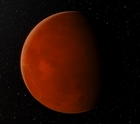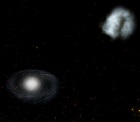|
Teran System
|
|
| Diakonov | Date: Friday, 29.01.2016, 01:00 | Message # 16 |
|
Astronaut
Group: Users
 Brazil
Brazil
Messages: 69
Status: Offline
| Raxjama is similar to Titan, but bigger and hotter. And has one thing not visible on Titan... complex life, purple vegetation that use all that infrared light. Has 3 small moons.

Ulonia is similar to Raxjama but colder, more similar to Titan, but still has life (more scarce) and... is 90° tilted, like Uranus. Has one small moon and some asteroids.

Ashajira's surface is full of cracks and has liquid nitrogen on the surface sometimes. The marks of those nitrogen seas appear through the surface, these occur are rare. In fact, ponds of liquid nitrogen occur more than seas.

Ijilha is similar to Ashajira but is colder and the atmosphere is so low that most parts of the surface appear to be already in space. It's as massive as Mars.

Maurin is just a blue sphere of ice, cracks and craters. Air pressure similar to martian.

Dwurf is even smaller and colder, and greener too. Almost airless. Same mass as our moon.

The only thing that still need to be done are dwarf planets and comets. Soon I'll show Teran A system.
Teran B has 12 planets.
Edited by Diakonov - Friday, 29.01.2016, 01:08 |
| |
| |
| Lucas0231 | Date: Saturday, 30.01.2016, 09:56 | Message # 17 |
 Explorer
Group: Users
 France
France
Messages: 150
Status: Offline
| Nice worlds, Diakonov !
|
| |
| |
| Diakonov | Date: Monday, 01.02.2016, 03:43 | Message # 18 |
|
Astronaut
Group: Users
 Brazil
Brazil
Messages: 69
Status: Offline
| Some inevitable changes ocurred, but minimal. Forgot to say that Teran A and B planets are mostly silicate and Teran C planets are mostly carbide. Teran C planets are poor in water, but not in oxygen in form of CO, for example and instead of water, the colder are richer in hydrocarbons and the hotter in ammonia or sulfur compounds.
|
| |
| |
| Diakonov | Date: Thursday, 04.02.2016, 03:21 | Message # 19 |
|
Astronaut
Group: Users
 Brazil
Brazil
Messages: 69
Status: Offline
| Now, it's time for Teran A:
Teran A is the biggest planetary system of Teran. It has 4 evaporating planets, many dwarf planets and comets. This system is divided in 3 parts. Inner system (evaporating worlds), middle system (more similar to Earth, but super earths) and outer system (one oceania, two gas giants, another oceania and some icy worlds). In the first oceania water act like a superfluid and the second is tilted like Uranus and the ocean is made of hydrocarbons. It's still in development and soon it will be shown.
|
| |
| |
| Diakonov | Date: Thursday, 04.02.2016, 18:57 | Message # 20 |
|
Astronaut
Group: Users
 Brazil
Brazil
Messages: 69
Status: Offline
| The inner Teran A system:

Scodwa:

Abati:

Besk:

Troisnu:

All these worlds are very hot and are evaporating for billions of years. Scodwa has 0,25 Me and pressure similar to Mars, but the air made of heavier compunds. Abati has 0,5 Me and 0.1 atm. Besk is the most extreme world, with 0,75 Me, 10 atm and 1042°C. Is the planet the evaporates most and is that will evaporate for even more billions of years. Troisnu has 1 Me and 25 atm. It's tail is smaller due to the lower temperature of 450°C, even though it's still very near to the star and is the most similar to Venus.

Sunset in Scodwa.
Between the inner and middle system, there are 10 dwarf planets.
Sulfona:

Sulfona is the first planet of the middle part of the system. It's atmosphere has sulfur and chlorine compounds (toxic to humans) and the seas are green due to sulfur and chlorine compounds dissolved in water too. Vegetation is purple and there's intelligent life, one of them an insectoid type. It has 3 Me, 3 atm, 73°C and 1.3 g. Sulfona is also tide locked. It's moon called Anoflus looks dead, but has some minor volcanic activity and very thin atmosphere.
Ikpela:


Ikpela is a tropical world with many jungles and deserts too. The beaches are very extense. Still has sulfur and chlorine compounds but in lesser concentration. 4 Me, 5 atm, 30°C, 1.17 g and 1.5 days. It has intelligent life, most of them look like dinossaurs. It's moon Alepk is a venusian type, but the air is thin, but still very hot, about 300°C due to intense volcanism. I'm thinking to add a gas tail in it, due to the high heat and low mass.
Lamak:


Selena:

Lamak is similar to Ikpela but bigger and a bit colder. It has 6 Me, 7 atm, 15°C, 1.56 g and 1.25 days. Has many intelligent species, very varied from aquatic to aerial, and terrestrial too mainly. In Teran systems, the vegetation of most terrestrial worlds similar to Earth absorb green, yellow and orange and part of the infrared light too, reflecting red and blue, resulting in pink or purple vegetation. It's not chlorophyll, but other substances. In most sulfuric worlds, vegetation tend to reflect green and purple and on most titan worlds, it's also purple or black. Lamak moon's called Selena. It has tropical climate and an atmopshere rich in greenhouse gases, resulting in a pink atmosphere and also has complex life.
Posema:


Posema is in an eternal ice age, but it's still not entirely a snowball. It's forests are very similar to our temperate forests. It also has intelligent life, but less diverse. All plateaus and mountains are covered by snow. It has 5 Me, 6 atm, 0°C, 1.36 g and 1.33 days. It's moon, called Marinhus, is a snowball and even has dense polar caps, air pressure similar to Mars. It looks a cold dead world but... it has life, complex, under the ice. In fact, not the entire surface is made of ice. In fact it's a rocky world covered by dense snow, but under some regions there are big seas, most of them tearing with life, kept by intense subaquatic volcanism, due to the proximity of the moon from the planet. Sometimes the ice break and expose the seas to the atmosphere, and it rapdly freeze again.
Tempestra:

It's an oceania type. The ocean is so hot that acts like a superfluid, not a liquid. It's similar to what may occur in Venus to CO2, but the superfluid ocean is so dense that you cannot see the deep rocky surface. Lifeless. One of it's moons, called Fishen, is very similar to Europa, but darker. It has a deep global ocean under a thin icy crust. At least in this moon, life is present, and abundant too, on the ocean floor.
Later I'll show the outer worlds.
|
| |
| |
| Diakonov | Date: Saturday, 06.02.2016, 03:51 | Message # 21 |
|
Astronaut
Group: Users
 Brazil
Brazil
Messages: 69
Status: Offline
| Before posting the last part of Teran A system, I made my addon a bit more interesting...
Teran C is, in fact, older than the binary pair. While the binary pair have silicate-rich worlds, the other star have planets more rich in carbon, meaning it has not formed in the same region of the pair, it was captured some billion years ago, and now it has a more eccentric and inclined orbit. While the pair have 5 billion years, the other star have 7.5 billion years. I'm thinking to add a brown dwarf, that also has an orbit similar to Teran C, and it was also captured. And maybe some starless planets...
|
| |
| |
| Diakonov | Date: Saturday, 06.02.2016, 14:34 | Message # 22 |
|
Astronaut
Group: Users
 Brazil
Brazil
Messages: 69
Status: Offline
| Now, the rest of Teran A system... and maybe some more.
Venuaran:



Have half Jupiter mass, very bright auroras, saturn-like rings, it's Saturn + Jupiter. It has 8 big moons. Some are similar to Enceladus, Europa, Ganymede, but three of them are similar to Titan. Below we have Samoina, it's Titan mixed with Io and Venus. And below we have Nirkmana and Mosklav, two other titan-like. All these 3 moons have complex life.
Hokmoz and Neik:

Hokmaz have 0,375 Mj, some small moons and a big one, called Neik, also similar to Titan.
Artsepmet and Sorash:

The planet and moon are both oceanias and are tilted like Uranus. They are like dad and son. The moon is hotter than the planet, due to the strong tidal force of the planet. Artsepmet has 10 Me and is around -175°C, and Sorash have 0,1 Me and is -135°C. Artsepmet has a global ocean of hydrocarbons and Sorash also have hydrocarbons. Both have a layer of ammonia at the bottom, so these worlds have 2 oceans, one below the other.
Britsama:

Much like Felnios, it has oceans of liquid nitrogen and complex life based on ?. Too cold, brrrr! It has an icy moon, with an underground ocean.
Dhonknad, Rombdora and Trakna:

It's a titanian version of Pluto and Charon plus a moon. Despite the long distance to Teran A, both are almost as hot has Nirkmana due to the fact they are very near each other. So volcanism is very intense. Unlike Pluto and Charon, this pair is really alive, geologically and biogically too! Trakna gives a little more tidal heat too to the pair.
Desolanus:

This time a typical icy planet, like Pluto. It's alone, distant and desolate!
Until now, Teran A has 16 planets.
Now Teran A, B and C have a flare effect. I decided to show what would be these stars in their flare moment.

And yes, the inner planets are all inside the flare!

Teran A seen from Lamak.

And now the sunset of Brakma is even more spectacular!
There are billions of red dwarf systems out there but... I think Teran systems are very unique!
Edited by Diakonov - Saturday, 06.02.2016, 15:14 |
| |
| |
| Diakonov | Date: Sunday, 07.02.2016, 14:40 | Message # 23 |
|
Astronaut
Group: Users
 Brazil
Brazil
Messages: 69
Status: Offline
| A new planet in Teran A system, it's called Clorona, and a moon called Clarium. It's a planet in which it's atmosphere is rich in sulfur and chlorine compounds. Vegetation is blue and cyan.



I've added some starless lone planets orbiting around the pair in very distant orbits. Most of them are more massive than Jupiter, but still not brown dwarf. One of them, called Fgawos, is a brown dwarf with 15.7 Mj.

Fgawos and it's hotter moons.

The first and hotter little sun.

Earth-like moon.

The "chemical laboratory" moon.

The main resource of volatiles.
Every world has it's importance, it's like Fgawos system is a living organism. The planet is like the skeleton, it keeps the system itself. The first and second moons are the source of light. The third spread some substances to space that the other moons will capture. The fourth moon is the source of heavy elements. The fifth moon is where intelligent life is present, that will later enchant the system in some way. The sixth moon is like a chemical laboratory to these intelligent creatures. And the seventh moon is a big source of volatiles. The system itself appears to be created artificially, but in fact, not. This system is very unique in many ways!
|
| |
| |
| Diakonov | Date: Sunday, 07.02.2016, 20:31 | Message # 24 |
|
Astronaut
Group: Users
 Brazil
Brazil
Messages: 69
Status: Offline
| Before I put the download like, I only like to say that some planets and moons have custom atmospheres, so i'll include the atmosphere.pak in the file, also each estar correspond to a single file. There are in total 5 files. One for the barycenter, 3 more for each star and one extra for those lonely planets. But I'm certain that my add-on is interesting enough to compansate the complex installation.
Edited by Diakonov - Sunday, 07.02.2016, 20:33 |
| |
| |
| quarior14 | Date: Saturday, 23.04.2016, 11:03 | Message # 25 |
 World Builder
Group: Users
 Pirate
Pirate
Messages: 649
Status: Offline
| Do you plan to make a version for RC2, in addition, you may configuration to atmospheric compositions. Also for atmospheres.cfg, you must name another name, such TeranAtmosphere.cfg but always in the atmospheres folder.
The system is very beautiful.
Quarior
|
| |
| |
| simonecinque1992 | Date: Monday, 20.06.2016, 12:06 | Message # 26 |
 Pioneer
Group: Users
 Italy
Italy
Messages: 470
Status: Offline
| Diakonov, Cool system! Can't wait for the download link! :3
My Mods and Addons
Packard Bell
Windows 10 Pro
Intel® Celeron® CPU 1000M @ 1.80GHz 1.80 GHz
4 GB
64 bit Operative System
|
| |
| |